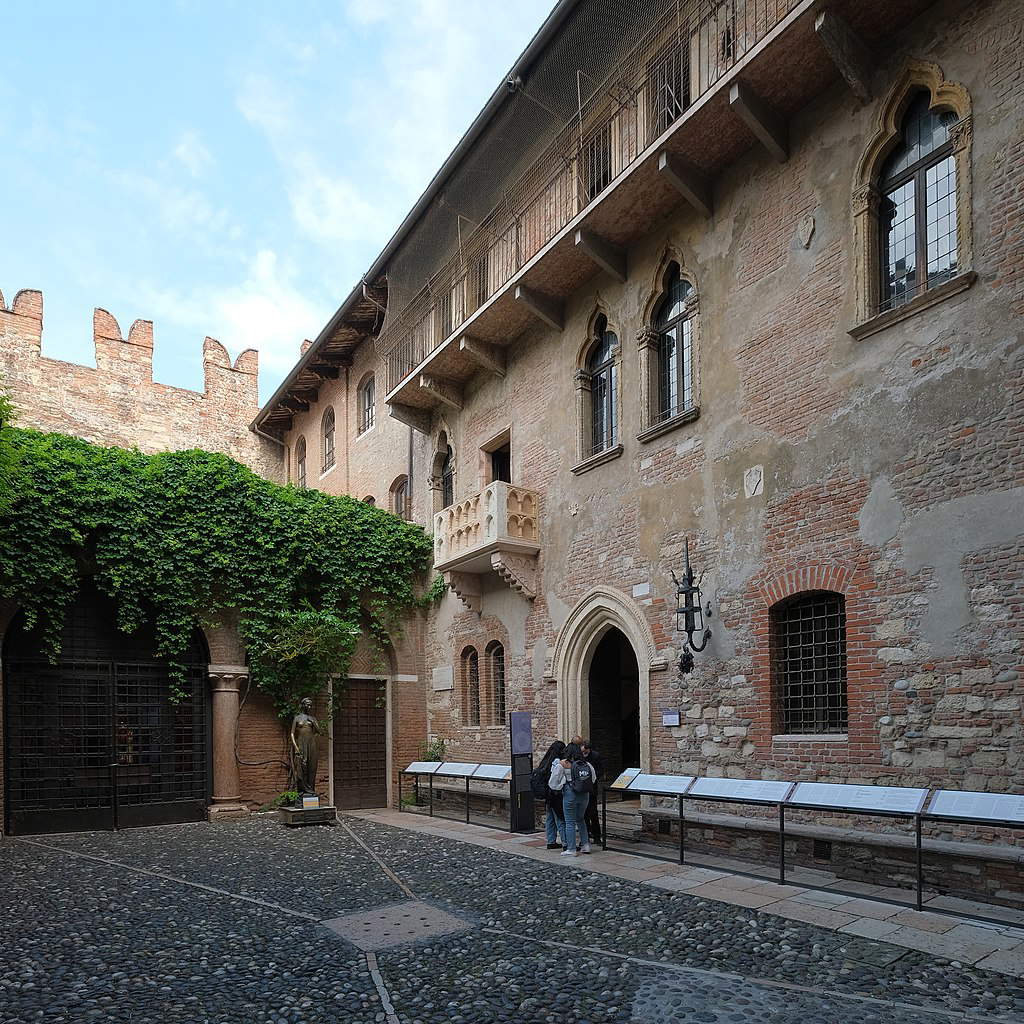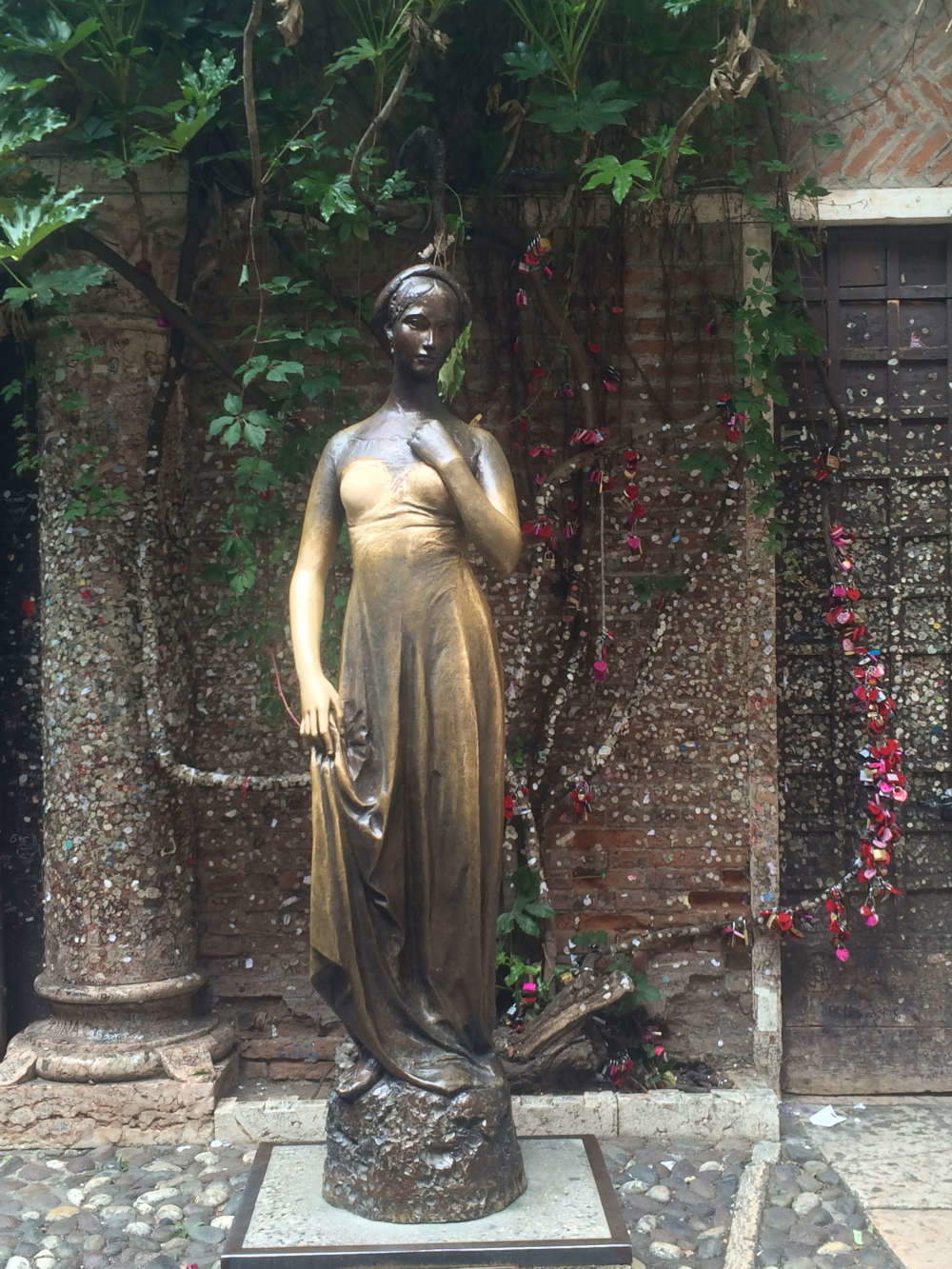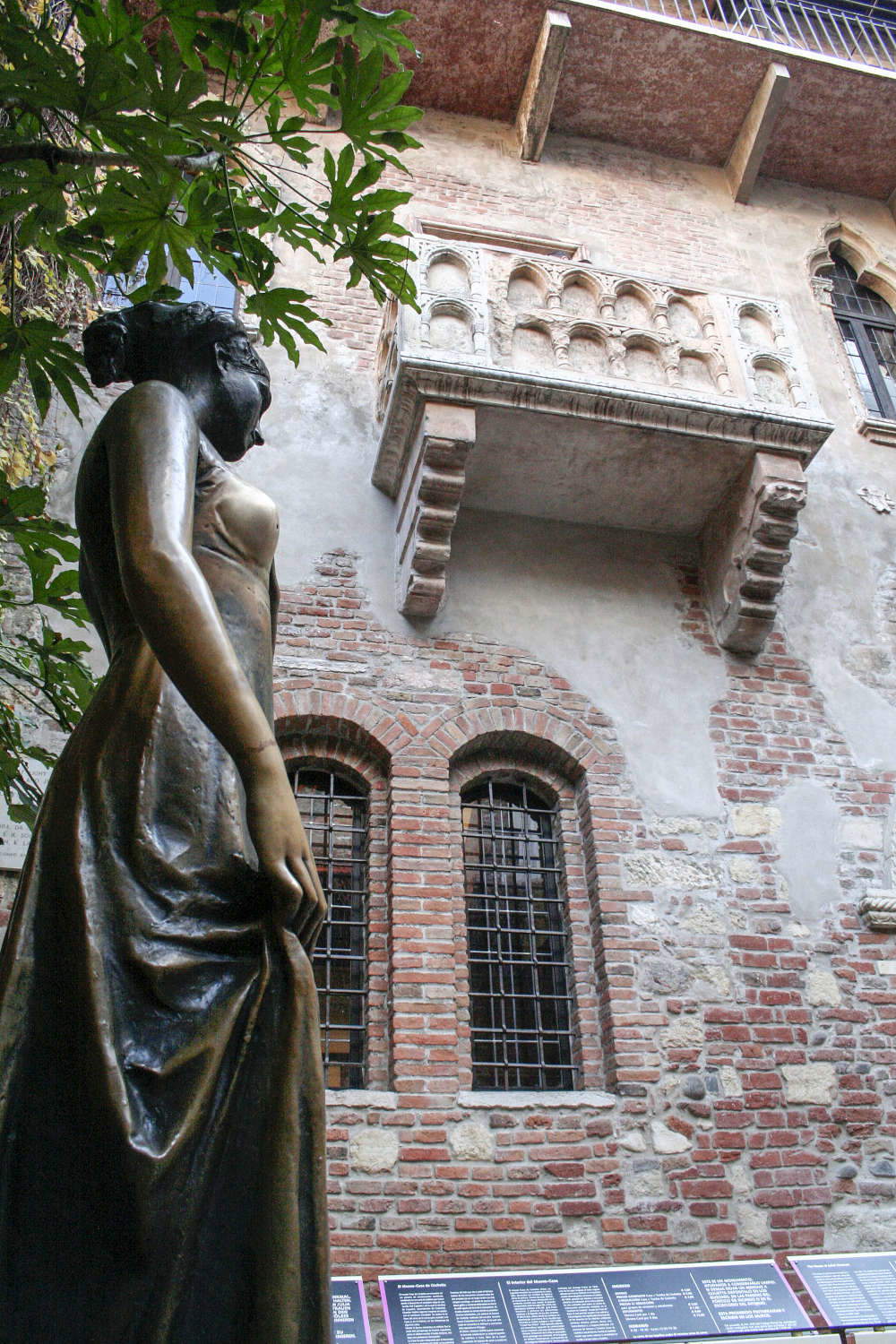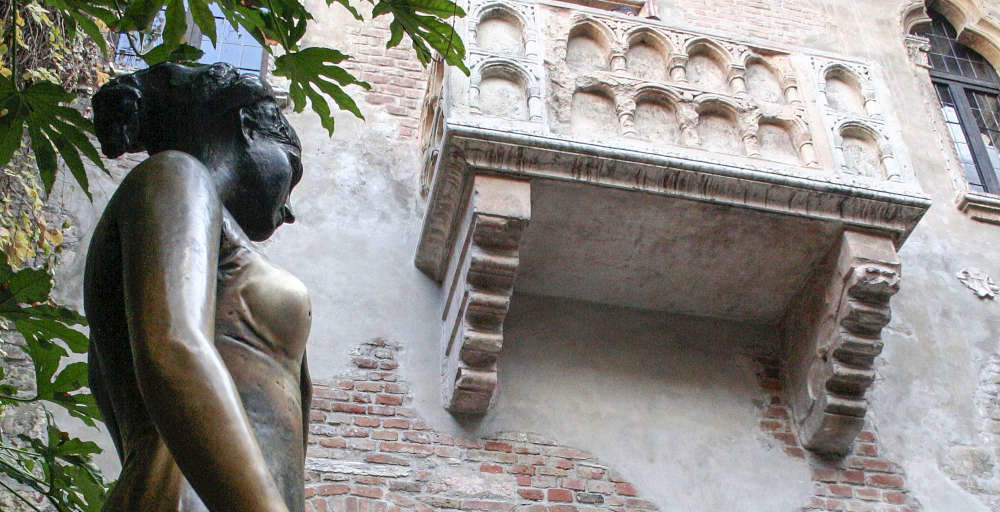Too much groping, damaged the breasts of Verona's Juliet. But is the superstitious gesture sexist?
As much as it is a farce, a fake place, recreated to evoke the story of Romeo and Juliet despite not being the place of the dialogue from the balcony between the two lovers at all, tourists when they enter Verona’s famous courtyard (it is not even known if Romeo and Juliet actually existed: the palace with the courtyard belonged to the Cappelli family, and the balcony was applied to the tower house in 1939 by the then director of the Civic Museums Antonio Avena), and find a statue with female features to which they associate Juliet’s identity, they simply touch her breast. Just as at the end of a pilgrimage the Christian would arrive at St. Peter’s and touch the foot of the bronze statue of Peter placed inside it, as if to say, “I have arrived,” so much so as to consume it, so in Verona the bronze layer of the statue of “Juliet” has come to be so worn away that its hollow interior can be seen. It has worn away, corroded, creating openings right on the breast. On the website of the city’s daily newspaper, L’Arena, the Ansa video showing the hole. It may not seem like much, the statue in fact is a copy, but the news went around the world and in the English playwright’s homeland the news was prominent on the home page of the Guardian website.
A ritual, that of touching the exposed breast with attached photo and selfie, somewhere between goliardia and irony (bordering on erotic subtext) that produced the result these days, after ten years of thousands of hands passing over it. It should be pointed out that the statue in the courtyard placed under the famous stone balcony is a copy of the statue forged in 1972 by sculptor Nereo Costantini (commissioned by the Verona Lions Club) and installed at that time. The original is kept inside the House Museum, and the copy was installed in 2014 precisely to prevent wear and tear given the similar signs of wear and corrosion always on the right breast and arm. The decision to replace the statue stemmed from the heartfelt plea of Juliet’s Club founder Giulio Tamassia, who worriedly warned everyone of the signs of time and tourists: “People are climbing the plinth and clinging to the statue. One day it might give way and endanger the safety of visitors.” So it was that sculptor Novello Finotti, a renowned master who was a pupil of Costantini, made the copy with Fonderia Brustolin.

In that courtyard on Via Cappello lives the story of the lovers par excellence in Shakespearean myth, making it a major attraction on par with a large museum of (real) works of art, thanks in part to the possibility of getting married there and looking out from the famous balcony, thanks to the “Getting Married in Verona” project for which couples from all over the world come. Touch corrosion on the breast and right arm has created holes, a few millimeters in size, in just 10 years, apparently due to the acidity of the sweat of the hands that come here from all over the world to pose and take a photo touching the statue. Thousands and thousands of times a day: access to the courtyard is in fact free, the ticket is paid only to visit the House Museum. That is why the City Council with the start of the renovation of the access to the courtyard and the opening of a new entrance from the Teatro Nuovo (maintaining only the exit from the courtyard) on an experimental basis, is testing the ground for the introduction of the ticket for the courtyard as well.
Now the City Council will have to consider an intervention on the copy and reflect on the context, but the occasion has rekindled controversy over the ’sexist’ gesture of groping on the breasts in an era, that of today, of a different conception of women than in the past, made up of emancipation, rights, and poltically correct: can a symbol of world literature be used as a ’woman-object’ (although in this case the statue is already an object in itself)?
In 2018 there was a petition launched on a web platform by Michela Morellato, an influencer, who decided to start this campaign because of the indignation she felt seeing the smirks of young tourists: “I was with my daughter,” she explained at the time on the petition, “when I witnessed a gruesome scene where, young teenagers, were instrumentalizing the statue of Juliet as if she were a Babydoll. How is it possible, I asked myself, that in 2018 we can allow this? How is it possible that some traditions lead us, every day, to instrumentalize the body of a woman, mostly in this case, a teenager?” And he provocatively proposed installing a statue representing Romeo next to her with his intimacies in view to “see who will want to touch his testicles. I want to raise awareness and promote a culture where every person can reflect on the deeper meaning of gestures and thus end the instrumentalization of the female body.” Probably the reference was to the testicles of the Bull statue on Wall Street in New York City where tourists and financiers passing by pass a touching for superstitious purposes.
Medesima controversy opened in December 2023 when a former Tuscan school principal visiting Verona in the courtyard of Casa Capuleti witnessed a similar scene. He wrote to Antonio Ricci’s well-known television program Striscia la Notizia, which did a story on it, complete with interviews with tourists in Verona who cleared the gesture described as ’harmless.’ The school leader complained that it was “unbelievable that the city administration or women’s rights associations” would not take action “to interrupt this collective public defacement of Juliet’s body and museum heritage, and stop such vulgar sexist gestures, to curb the absurd and nachronistic collective practice operated in Verona by having a vigilante” garrison or “a higher base” put in place.
But it is also astonishing that a school leader would go to what is for all intents and purposes a film set and not a historic site. The Juliet House website also makes this clear: the museum belongs to the City of Verona, and it is explained that “Juliet’s House Museum, one of the most famous places in the city Scaliger and an absolute reference point for lovers from all over the world, is housed in a medieval palace in Verona where, probably, since the 13th century, the Dal Cappello family, which gives its name to the street and whose emblem is carved in a relief in the keystone of the inner arch of the building’s courtyard, resided. The building, located on the delightful Via Cappello, a short distance from the central Piazza Erbe, has undergone numerous restoration and renovation works over the centuries, passing through the hands of different owners. Meanwhile, the legend and popular belief that identifies it as the birthplace of Juliet Capulet, the protagonist, together with her beloved Romeo Montague, of the celebrated Shakespearean tragedy, grew, and the Municipality of Verona in 1907 saw fit to acquire at least part of the entire medieval-age complex.” And here’s the bitter truth about the fake balcony: “The famous balcony is the result of the assemblage of 14th-century marble remains that, until 1920, lay at the Castelvecchio Museum as stones to be re-employed, according to the architectural fashion of the time. The medieval mansion, picturesquely restored by Antonio Avena in the early 20th century, has a beautiful brick interior facade, a Gothic-style portal, trefoil windows, a balustrade that connects the various bodies of the house from the outside, and, of course, the famous balcony. In the courtyard is placed the bronze statue of Juliet, by Nereo Costantini.”


Avena then activated a far-sighted ante litteram territorial marketing strategy by intoning on Verona the Shakespearean myth by creating the environments where these could attract tourists, mixing neo-medieval style decorations made from scratch on walls and ceilings together with elements from civic collections, such as stones, small columns, fireplaces, coats of arms and furnishings dating between the 13th and 15th centuries. And since the chosen courtyard lacked the mythical balcony of the dialogue between the two lovers, he chose one destined for the scrap heap and adapted it (as Alberto Vignolo explains in the arrticle “Sei un mito,” in the magazine of the Veronese order of architects “ArchitettiVerona,” vol. 03, no. 122, July/September 2020, pp. 78-81.): “the two red marble corbels were specially made, while a medieval slab from the civic collections was recovered for the balustrade. Given the small size of the slab, two lateral extensions and side closures were made of white marble and Avesa stone, on which the same arches as in the central part were reproduced.”
In front of many museums one struggles to find queues of tourists while for an ’artificial’ place that simply evokes the story of a literary drama one is faced with mass phenomena with people coming from all over the world. And there is also the question of whether a copy of a bronze statue inspired by a fictional character should be protected. What kind of society are we living in? It is well understood that tourism today is done with influencers and not with substance, just what whets the appetite is enough, the more imaginative it is, the more desirable and trackable it will be. It makes no difference if that place is like a movie set and nothing else, a Disneyland where the buildings evoke fairy tales or cartoons. Reading those who argue that we need to defend the statue of Juliet than sheets of glass comes to mind that we do that for works like the Mona Lisa, just to name one. Hats off to those who already in the 1930s understood this by turning the plot of a literary work first into myth and legend and then into places to charge a ticket. But where would art be? Where would the culture be?
 |
| Too much groping, damaged the breasts of Verona's Juliet. But is the superstitious gesture sexist? |
Warning: the translation into English of the original Italian article was created using automatic tools. We undertake to review all articles, but we do not guarantee the total absence of inaccuracies in the translation due to the program. You can find the original by clicking on the ITA button. If you find any mistake,please contact us.




























